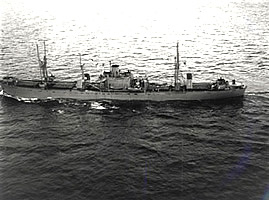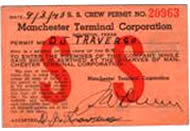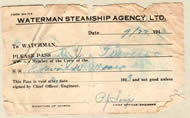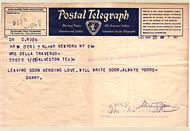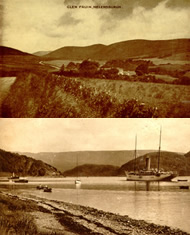Voyage Two
SS Edwin W. Moore - Page 1
During the last week in August I went to the SIU hall and caught a ship - another brand new Liberty ship just off the ways at the Todd Shipyard in Houston. The SIU hall was down on 20th and Mechanic or Post Office Street next to the old Screwman's Hall, the cotton longshoremen's union hall. You could go in and put your name on the blackboard or just sit around until they called out that they needed particular ratings to make a crew. Lot of guys would hang out in there playing cards, shooting the breeze, waiting for a call they liked. I would see friends in there and sometimes we'd sign on together or just be in there talking when "One-eyed" Wallace, the business agent, would call for a crew.
Johnston, Pedraza, Walker and I all signed on and we had just shipped previously together. Sometimes you'd sign up with acquaintances and other times find yourself in the same crew with former shipmates by accident. I took the bus up to Houston and boarded the SS Edwin W. Moore on August 31, 1943. The next five days were spent unpacking gear and fitting out the ship and getting her up and running. On 5, September we sailed down the Houston ship channel into Galveston Bay and into the port of Galveston. We took on a mixed cargo of sulfur and cotton. ( At 1635 hours on September 8, 1943 the Edwin W. Moore sailed for New Orleans, and on to Key West, Florida; to Savannah, Georgia; to Norfolk, Virginia; and into New York. Ships attached and left the convoy along the way with convoy size varying from 12 to 17 ships, including cargo, tankers and three LST's. The ships were escorted by patrol craft and had air cover from several types of planes and Navy blimps, with coverage - "never very continuous". - armed guard report of Ensign Harry Karnemont )
I shipped utility man on the Moore. I helped out in the galley - cleaned up everything and that was much harder work than being messman. There were guys that I had shipped with before. Johnny Johnston was deck engineer; and Johnny Pedraza a was fireman; Walker was the first cook; and Taylor was third cook. That was the first time I shipped with Mike La Soya, but I would ship with him several times. LaSoya and Huffacre were A.B.'s, Clyde Couch was a messman, Billy Baker was in the crew and so was Pedraza's brother. I shared a foc's'le with two messmen, David Gonzalez and Joe Pettus. David was from Texas City or Galveston. I ran into him at a prize fight in 1948 and he was still shipping as a third engineer. Pettus was from Tennessee and gave me his address so I could look him up if I was ever up that way. They were good guys and we got along fine. The captain was an old man who had been torpedoed before, John B. Quinn. We sailed the same route as on the Burnett - to New Orleans where they put on torpedo nets and anti-magnetic mine cable and then around Florida and up the East Coast to New York. In New York they put on a deck cargo of Army vehicles. ( The Moore docked at pier 4 - Hoboken, New Jersey, according to a letter of 1/30/2000 by Mr. Harold Light who was a S1c in the Naval Armed Guard attached to the SS Edwin W. Moore. )
The SS Edwin W. Moore sailed from New York on September 27, 1943 in Convoy HX 259 for a position off Halifax. The armed guard reports that the ship lost the convoy in fog in the early morning of September 30th until 1700 G.C.T. October 2, 1943. Forty one ships were counted by Ensign Karnemont and of these, fourteen were tankers. The armed guard reports a corvette dropping depth charges on October 8, 1943, but that nothing was seen. HX 259 crossed the North Atlantic into the Irish Sea via the North Channel and arrived at the Mersey on October 12, 1943 and went into Liverpool and docked at King's 1 on the following day. The Official Log-Book for the voyage shows most of the cargo was discharged in Liverpool before departing October 17th for Garston, England where the rest was off-loaded. The ship left Gaston on October 27th and arrived the Firth of Clyde, Scotland , October 28, 1943. The Moore proceeded first to Greennock, Scotland via the River Clyde and then to Dumbarton, Scotland where the ship was loaded with ammunition. The Moore then was moved to Helensburgh, Scotland where one hold was loaded with crates of Scotch whiskey for the British Army. Mr. Harold Light who was in the Armed Guard wrote "some of which actually got to Sicily.
Convoys that I sailed in were pretty slow. You couldn't go any faster than
the slowest ship in the convoy. Some of the ships were pretty old - Hog Islanders
from World War I and few had been around since the turn of the century. The
Allies had put into service just about anything and everything they had that
would float. Of course Liberties weren't built for speed. I don't think they
could get more than 10 knots out of a loaded one. They had started building
C1, C2, and C3 cargo ships just before the war and they were faster. They
had fast convoys and slow convoys. Because of the ages of many of the ships
in my early convoys, I think they had to have been slow ones.
( Convoy HX
259 speed was from 8 to 10 knots. - Armed Guard Report )
A couple of days after we docked, I sent a telegram to let Della know that I had arrived safely. It was on this second trip to England that there were these two big tall skinny country boys, from Oklahoma. They were hard drinkers. They came into the galley just before we went ashore and asked me to get some containers of lemon extract for them. We went ashore together and I brought along several pints of lemon extract. They were mixing it in the dark English beer we were drinking. Extracts have an alcohol base. Christ they got me drunk - they liked to killed me. I lost my voice for more than a week.
Walker chewed me out. He said that I should have told him what we were going to do with the extract and he would have poured the bottles into an open container and frozen it. He said then you could take an ice pick and get the pure alcohol from the center of the ice where it wouldn't freeze. I came to find out that this was often how the first cook got drunk when after a long time at sea he had run out of liquor and had to resort to more creative ways of finding alcohol.
They must have thought that we were going straight back to the States because before we left England they took off all of our food stores. I guess the British needed food supplies badly at that time. But instead of home they sent us up to Scotland where they loaded us for a trip to the Mediterranean. Of course we in the crew didn't know where we were going at the time. They never told us anything, so we never knew where we were headed. We went to Greennock, Scotland first and on to Dumbarton, Scotland where we loaded all but one hold with ammunition. Then we move to Helensburgh and loaded the remaining hold with scotch whiskey.

